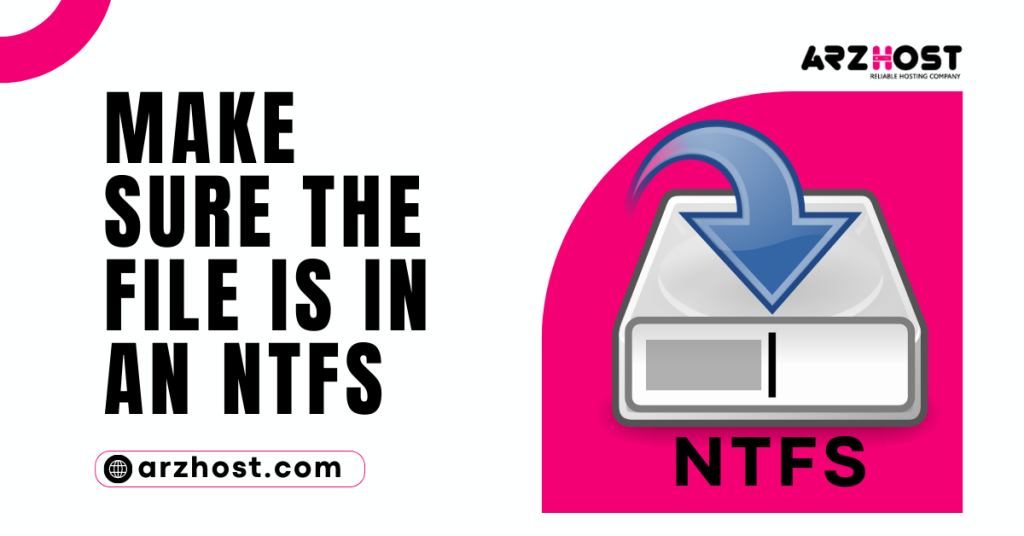Make Sure the File is in an NTFS, Pondering how to fix “Guarantee the File is an NTFS Volume and isn’t in a Compressed Folder or Volume” botch on windows? We can help you.
Regularly Windows customers report that they get this slip-up while trying to mount ISO records using Windows Explorer. This screw-up is as often as possible experienced after a particular Windows security update.
What is NTFS?
NTFS, which addresses NT report structure and the New Technology File System, is the record structure that the Windows NT working system (OS) uses for taking care of and improving archives on hard circle drives (HDDs) and solid-state drives (SSDs). NTFS is the Windows NT resemblance to the Windows 95 record segment table (FAT) and the OS/2 High-Performance File System (HPFS). In any case, Make Sure the File is in an NTFS, NTFS offers a couple of improvements over FAT and HPFS to the extent of execution, extensibility, and security.
How is NTFS used?
Microsoft Windows and some removable buildup devices use NTFS to enable, name, and store records. NTFS is an opportunity for getting sorted out SSDs – Make Sure the File is in an NTFS, where its speed is particularly significant – HDDs, USBs, and smaller than expected SD cards that are used with Windows.
Dependent upon the limit furthest reaches of the device, the OS used and the kind of drive, another record structure may be great, as FAT32 or Extended FAT (exFAT). Make Sure the File is in an NTFS, Each record system enjoys benefits and disadvantages. For example, security and approvals are additionally evolved with NTFS than exFAT and FAT32. Of course, FAT32 and exFAT work better with non-Windows OSes, similar to Mac and Linux.
How NTFS capabilities?
While presenting an OS, the customer picks a record structure. When masterminding an SSD or an HDD, customers pick the report structure they’ll use. Make Sure the File is in an NTFS, The most widely recognized method of masterminding each kind of drive is hardly remarkable, yet both are practical with NTFS.
Right when an HDD is coordinated or instated, it is separated into bundles. Portions are the critical divisions of the hard drive’s genuine space. Inside each portion, the OS screens all of the archives it stores. Each record is taken care of on the HDD in something like one error or plate spaces of a predefined uniform size.
About NTFS features
One particular characteristic of NTFS, Make Sure the File is in an NTFS, differentiated and FAT, is that it considers record approvals and encryption. Amazing parts of NTFS join the going with:
- Definitive usefulness: NTFS uses a b-tree list intend to screen report bundles. This is gigantic because it considers powerful organizing and relationship of records.
- Open data: It stores data about a record’s errors and diverse data in the MFT, not just in a general managing table moreover with FAT.
- Archive size: NTFS maintains incredibly huge reports.
- Customer assents: It has a passageway control list that lets a worker chief control who can get to unequivocal records.
- Strain: Consolidated record pressure contracts report measures and give all the more additional room.
- Unicode record naming: Since it maintains record names reliant upon Unicode, NTFS has a more typical report naming show and thinks about longer record names with a broader display of characters. Make Sure the File is in an NTFS, Non-Unicode naming shows a portion of the time require translation.
- Secure: NTFS offers security to data on removable and no removable plates.
- Requires less limit: It has support for deficient reports that replace void information – long series of zeros – with metadata that takes up a more unassuming volume of additional room.
- Straightforward volume access: NTFS uses mounted volumes, Make Sure the File is in an NTFS, which means plate volumes can be gotten to as standard envelopes in the record structure.
Advantages and bothers of NTFS
There are a couple of advantages and burdens to using NTFS, Make Sure the File is in an NTFS, which are consolidated underneath.
Advantages
- Control: One of the fundamental parts of NTFS is the usage of circle sums, which provides associations more order over the additional room. Heads can use circle amounts to limit the proportion of additional room a given customer can get to.
- Execution: NTFS uses record pressure, Make Sure the File is in an NTFS, which advisors report sizes, accelerating and giving associations all the more additional space to work with. It is like manner maintains incredibly gigantic archives.
- Security: The passage control components of NTFS let regulators place approvals on sensitive data, restricting induction to explicit customers. It similarly maintains encryption.
- Straightforward logging: The MFT logs and surveys reports on the drive, so chiefs can follow records that have been eradicated, added, or changed in any way. NTFS is a journaling record system, Make Sure the File is in an NTFS, which implies it logs trades in an archive structure journal.
- Constancy: Data and archives can be quickly restored if there should be an occurrence of a structure disappointment or error because NTFS stays aware of the consistency of the record system. Make Sure the File is in an NTFS, It is an inadequacy liberal structure and has an MFT reflect record that the system can reference if the vital MFT gets polluted.
Obstructions
- Limited OS likeness: The essential weight of NTFS is limited OS likeness; it is examined unmistakably with non-Windows OSes.
- Limited device support: Various removable devices don’t maintain NTFS, including Android cells, DVD players, and progressed cameras. Some various devices don’t maintain it either, Make Sure the File is in an NTFS, similar to media players, wise TVs, and printers.
- Mac OS X assistance: Working framework X contraptions have limited likeness with NTFS drives; they can examine them yet not stay in contact with them.
What causes the ‘Guarantee the File is an NTFS Volume and isn’t in a Compressed Folder or Volume’ Error on Windows 10?
This error isn’t a truly new thing, regardless, Make Sure the File is in an NTFS, there was something certain that made it trigger the most. Following are the factors that ordinarily cause it:
- Windows 10 security update: For most of the customers, the slip-up showed up after the appearance of the KB4019472 Windows 10 update which ended up being a security update. This update made the goof emerge for an enormous part of the customers.
- Space of ISO archive: At times, the misstep can be a direct result of the space or method of the downloaded ISO record. In such a circumstance, you should change the region.
You can separate your issue by following the plans down under. Make Sure the File is in an NTFS assuming no one minds, follow the given courses of action in a comparative solicitation as given to get your error settled quickly.
Changing the Location of the ISO File
The essential thing we can effort to fix the botch is to change the method of the downloaded ISO report.
Sometimes, Make Sure the File is in an NTFS, the error is set off by the area of the ISO record inexplicably. Regardless, we can fix this by moving the record to another drive.
Using Third-Party Applications
Sometimes, the mount part might be separating, in this manner achieving the bumble.
To fix this we can use pariah programming to mount the record.
The most conventionally used applications are PowerISO programming or Daemon devices. Make Sure the File is in an NTFS, Henceforth, presenting any of the applications can help us with mounting the archive without standing up to this screw-up.
Using the Windows PowerShell
On the off chance that we are at this point defying the screw up even ensuing to moving the record to another drive, we can effort to fix the error by taking out the insufficient standard. Make Sure the File is in an NTFS, This has to be conceivable using Windows PowerShell.
Following are the means for dispensing with the insufficient flag:
- First thing, go to the Start Menu and type in Windows PowerShell.
- Besides, right-click on it and run it as a regulator.
- After that enter the going with a request:
fsutil insufficient set flag "C:\FilePath\FileName.iso" 0
Make Sure the File is in an NTFS, If we get a ‘Passageway Denied’ message ensuing to entering the request, we can fix this by taking out the Read-only quality of the ISO record through its properties.
In like manner, guarantee that the ‘This record came from another PC and might be deterred to help with getting this PC’ decision is unchecked.
Make Sure the File is in an NTFS, At the point when the above progress is done, we can enter the request in the Windows PowerShell again.
Providing with the Windows Update
Make Sure the File is in an NTFS, We have to dispense with the security update to handle this misstep If nothing is based on what was simply referenced courses of action work out.
This has to be conceivable using the going with progress:
- In the first place, press Windows Key + I to open Settings.
- Besides, go to Update and security.
- Then, click on View Update History and a short time later select Uninstall invigorates.
- As of now, search for the KB4019472 update.
- Besides, twofold tap it to uninstall the update.
- Finally, restart the system and thereafter have a go at mounting the archive.
Conclusion
To lay it out simply, Make Sure the File is in an NTFS, we saw how our Support Engineers fix the “Guarantee the File is an NTFS Volume and isn’t in a Compressed Folder or Volume” Windows error for our customers.











